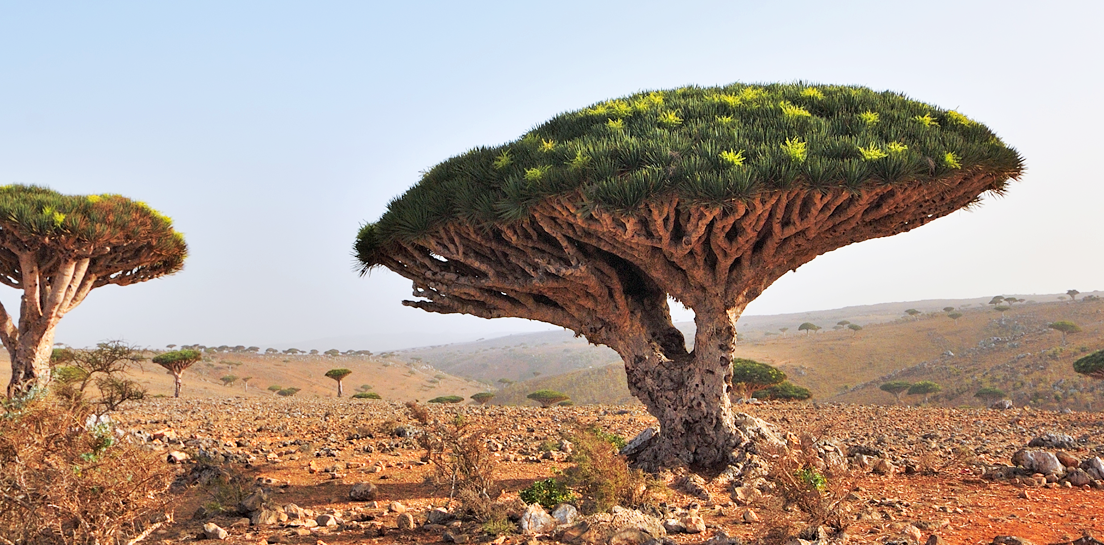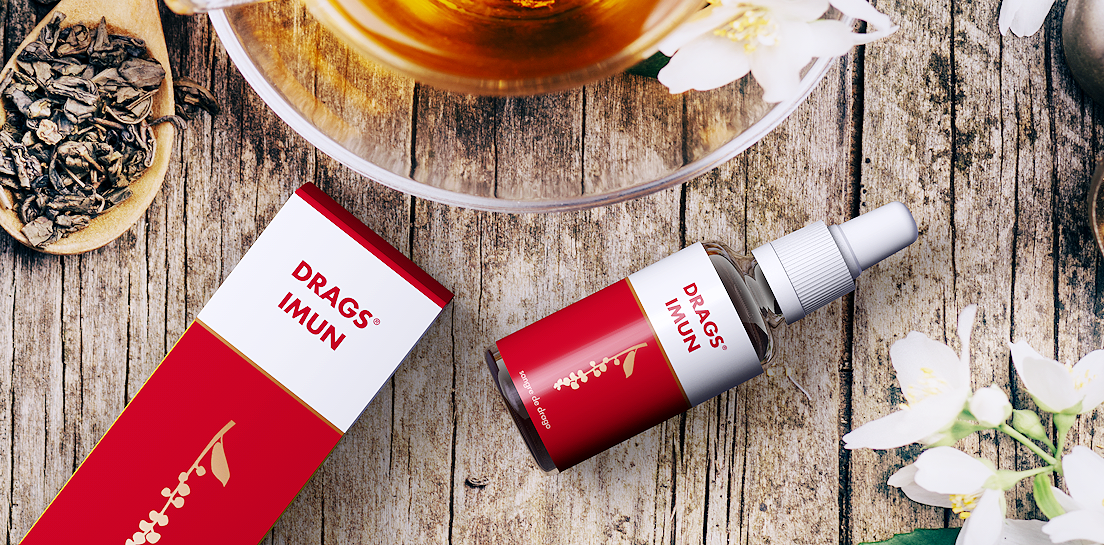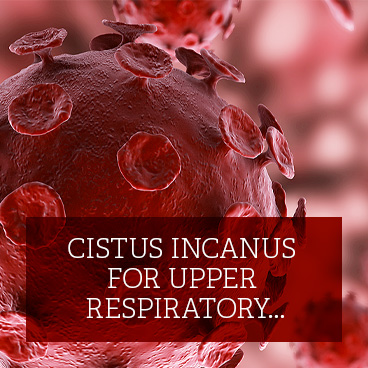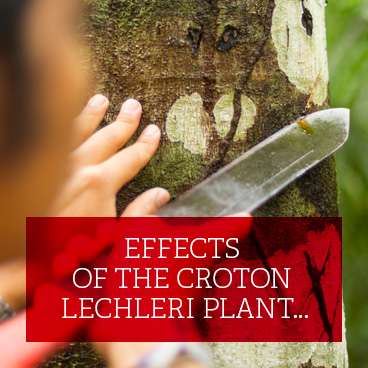Effects of the Croton lechleri plant contained in Drags imun
Dragon’s blood
Dragon’s blood (Drachenblut, Sangre de Drago) is a resin, or reddish-brown latex, exuded when the bark of certain trees is scratched or cut. It is collected and then used fresh or dried. “Dragon’s blood” denotes latex from four different trees in the three continents: the Dracaena draco, a tree native to the Canary Islands, the South Asian Daemonorops draco, the West Indian tree with flowering fruit Pterocarpus draco, and certain Croton species native to the rainforests of Central and South America. In recent decades, the entire “civilised” and “cultural” world has been drawn to fascinating reports of South America’s “miraculous” rainforest herbs that can often cure problems that contemporary scientific medicine is unable to solve. With this in mind, we, too, will focus on the dragon’s blood (Croton spp.), hailing from South America.Croton lechleri
A tree standing up to 30 metres tall (an average of about 15 metres is usually cited), its upper parts are always densely branched. The young branches and leaf stalks are greyish-red, making it appear that they have been attacked by parasitic fungi. Despite their considerable height, the trunk diameter is not usually more than 30 cm. The trunk is covered with smooth richly stained brown-grey bark. The leaves are cordate, light green, and between 12 and 30 cm in length. The flowers are a unique light greenish-white in spiky inflorescences on long stalks. The male and female flowers have the oval shape of a five-petal calyx. The androecium (the male genital organ) comprises eleven stamens. The gynoecium (the female genital organ) has three parts, an ovum covered with light orange pubescence, and a stigma branched into two parts. The fruit is a reddish three-part 4-5 mm wide capsule with pubescence. Seeds are smooth and oily.The tree occurs in humid (wet) rainforests at elevations of 125 to 2,080 m. It is most common in areas of “regeneration”, which makes its commercial cultivation easier. In Peru, it occurs in the Amazon, San Martín, Tarapoto, Ucayali, Huánuco, Pasco, Juin, Cuzco, Madre de Dios, Loreto, Morona-Cocha, Mishuyacu, and the Nanay River. It can also be found in Colombia, Brazil, Ecuador, Bolivia, and elsewhere in the region.
If the tree bark is cut or skinned, it exudes a dark red, juicy, foamy sap. It was first “introduced” to our civilisation in about 1600 by the Spanish Jesuit, chronicler and naturalist Padre Barnabé Cobo, who described it primarily with an emphasis on the ethno-medicinal use of latex by the indigenous communities of Mexico, Colombia, Ecuador and Peru. It was not classified botanically until almost a quarter of a millennium later – in 1866.
It is most often cited as a typical representative and “producer” of dark-coloured latex, known as “dragon’s blood”, from the species Croton lechleri Muell. Arg.

In indigenous medicine, especially among Central and South American communities, Croton spp. tends to be used to treat a very wide range of diseases. The latex of Croton spp. is regularly administered orally, but can also be applied as a means of external treatment [Chen et al., 1994].
It was most commonly used to stem bleeding, accelerate healing, close wounds, and protect injuries from infection. The sap dries quickly to form a second skin. The indigenous people of Peru use it internally for leucorrhoea, fractures, haemorrhoids just as much as for gastric ulcers. Other tribes also use it for dysentery, intestinal fever, pyorrhoea, vaginal baths before birth, for stemming postpartum haemorrhage and for skin problems such as eczema and irritating insect bites.
It is used internally for haemorrhoids, mouth ulcers, tonsillitis, throat infections, tuberculosis, gastric ulcers, digestive disorders, rheumatism, and fertility.
Pharmacological properties of the latex and substances isolated from it
Antiviral and antibacterial activity
The latex acts antiseptically, as a potential antiviral and bacteriostatic agent [Chen et al., 1994]. In 1985, an anti-inflammatory, antiviral, and anti-sarcoma effect was documented. Belgian scientists have also confirmed the antiviral effects of taspine and dimethyldicrus against herpetovirus. In 1994, other phytochemicals, including phenols, proanthocyanidins and diterpenes, showing certain antibacterial activity, were discovered. Taspine studies in 1977 demonstrated its ability to inhibit the RNA-DNA polymerase in myeloblastosis virus, Rauscher leukaemia virus, and Simian sarcoma virus.Croton spp. extract was shown to inhibit reverse transcriptase activity [Sethi, 1977]. Tests performed with Croton spp. latex have excluded cytotoxicity [Chen et al., 1994]. Several simple phenols and diterpenes have shown strong bacteriostatic activity [Chen et al., 1994].
Studies of the bacteriostatic activity of Croton spp. latex clearly demonstrated that this activity was very strong (in any event up to 30 times stronger than the chloramphenicol and penicillin V used as controls) in relation to at least two bacterial strains [Chen et al., 1994]. The most common components of the latex, proanthocyanidins [Cai et al., 1991; Chen et al., 1994], once isolated, exhibit only limited activity against a specific strain, unlike their probable substantially wider and stronger activity when they act in synergy with other components in the latex as a whole [Scalbert, 1991] .
Cicatrisation (wound healing)
Croton spp. extract was shown to promote wound healing [Vaisberg et al., 1989]. It has haemostatic properties (it is very effective at stemming bleeding and sealing wounds, including the moderation of Herpes simplex lesions etc.) [Chen et al., 1994]. Sangre de Drago’s wound healing and cicatrising effect on open injuries was attributed to taspine in 1989. In 1991 and 1993, several follow-up studies centred on the healing and anti-tumour properties of taspine. In 1993, scientists isolated the lignan dimethylcedrusin, which also played a significant role (alongside taspine) in the wound and scar healing process. A Belgian study proved the effects of the latex in stimulating the contraction of scars (wounds). It significantly helps to create new skin formation and promotes the regranulation of the subcutaneous tissue and collagen production. A comparative study showed that the raw sap was able to heal wounds and form collagen formation four times more efficiently than the isolated components of dimethylcedrusin or taspine.
Antiphlogistic (anti-inflammatory) activity
Croton spp. extract was shown to have anti-inflammatory activity [Perdue & others, 1979]. The antiphlogistic activity of taspine was first documented in 1979. Taspine reported anti-inflammatory activity in three model pharmacological studies: in a study of the effects of the development and moderation of carrageenin-induced oedema in rats, in a study of the effects of the development and moderation of granuloma in rats, and in a study of coadjuvant-induced arthritis in rats. These studies demonstrated the antiphlogistic activity of taspine, but also revealed that it was not only taspine that reports this activity. In a comparison of the results of taspine and latex as a whole, significantly better results were obtained when the latex was applied as a whole. The most striking result was achieved with the interperitoneal administration of latex in the study of the effects of the development and moderation of carrageenin-induced oedema in rats.
Antidiarrhoeal activity
C. lechleri latex demonstrated the ability to inhibit intestinal hypersecretion caused by the cholera toxin, depending on the dose administered. Additionally, inhibition of forskolin-induced chlorine secretion was demonstrated in vitro. These therapeutic activities were effectively utiltised in the last cholera epidemic in Peru in 1993, when latex administration certainly saved the lives of hundreds, if not thousands, of patients.
Immunomodulatory activity
Saving the best till last: in the concept of allopathic (clinical) medicine, only one in a long list of latex activities, in the sense of holistic medicine, a primary and decisive activity. The product name Drags imun was not a flippant choice. In the holistic view of medicine and the treatment of health, the importance of properly functioning immunity reflects the harmonic functioning of the body as a whole.If the body’s metabolism is working harmoniously, the human organism has enough means (defence mechanisms) to cope on its own with any aggression coming from outside. (If the metabolism is functioning harmoniously, we can rule out the development of a disease or symptom due to metabolic disorder or insufficiency.) These mechanisms are perfectly described by immunology and, just as an aside, we mention here that the different defence mechanisms include the formation of specific antibodies of “immunoglobulins” (A, E, I, G, M), and also the ability of phagocytosis, i.e., absorption of the aggressor by its own cells (phages), leukocyte T proliferation, etc.
IN SEVERAL STUDIES THAT ARE NOT OFTEN PRESENTED, C. LECHLERI LATEX HAS REPORTED A HIGH ABILITY TO SUPPORT OR INHIBIT (DEPENDING ON THE TYPE OF DIRECT OR ALTERNATIVE SUPPORT OF THE IMMUNE MECHANISM) PHAGOCYTOSIS AND SUPPORT THE BODY’S IMMUNE RESPONSES, EITHER IN DIRECT OR ALTERNATIVE FORMS.
Mgr. Miroslav Dorazil
Follow us on social media
“Never doubt that a small group of thoughtful, committed, citizens can change the world.
Indeed, it is the only thing that ever has.”
Margaret Mead













